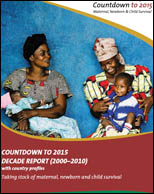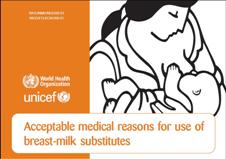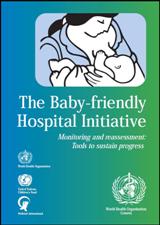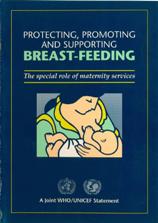Baby-Friendly Hospital Initiative (BFHI) > Resources
click > BFHI Training Materials >
Breastfeeding Resources > Breastfeeding and HIV/AIDS Resources
WHO: Baby-Friendly Hospital Initiative
UNICEF: Baby-Friendly Hospital Initiative
Revitalization of BFHI
Randa Saadeh, Scientist, Nutrition for Health and Development. SCN, Rome, 2007 -
 32 slides
32 slides 788 kb
The Innocenti Declaration: progress and achievements, parts I, II and III
Weekly Epidemiological Record, 1998, 73(5):25-32, 73(13):91-94 and 73(19):139-144
Geneva, World Health Organization 1998
English and French: Part I
¦
Part II
¦
Part III
Baby-Friendly Hospital Initiative -
WHO
Baby-Friendly Hospital Initiative (2009) - WHO
Revised, updated and expanded for integrated care
 Authors: World Health Organization, UNICEF
Authors: World Health Organization, UNICEF
Publication date: 2009
Languages: English
ISBN: 978 92 4 159495 0 (set)
Section 1: Background and Implementation
Section 2: Strengthening and sustaining the Baby-friendly Hospital Initiative
Section 3: Breastfeeding Promotion and Support in a Baby-friendly Hospital, a 20-hour course for maternity staff
Section 4: Hospital Self-Appraisal and Monitoring
Overview
The Baby-friendly Hospital Initiative (BFHI) is a global effort launched by WHO and UNICEF to implement practices that protect, promote and support breastfeeding. It was launched in 1991 in response to the Innocenti Declaration. The global BFHI materials have been revised, updated and expanded for integrated care. The materials reflect new research and experience, reinforce the International Code of Marketing of Breast-milk Substitutes, support mothers who are not breastfeeding, provide modules on HIV and infant feeding and mother-friendly care, and give more guidance for monitoring and reassessment.
The revised package of BFHI materials includes five sections: 1. Background and Implementation, 2. Strengthening and Sustaining the BFHI: A course for decision-makers, 3. Breastfeeding Promotion and Support in a Baby-friendly Hospital: a 20-hour course for maternity staff, 4. Hospital Self-Appraisal and Monitoring, and 5. External Assessment and Reassessment. Sections 1 to 4 are widely available while section 5 is for limited distribution.
Section 5. External Assessment and Reassessment, provides guidelines and tools for external assessors to use initially to assess whether hospitals meet the Global Criteria and thus fully comply with the Ten Steps, and then to reassess on a regular basis whether they continue to maintain the required standards. Section 5 is divided in three parts:
- 5.1 Guide for Assessors
- 5.2 Hospital External Assessment Tool
- 5.3 Guidelines and Tool for External Reassessment
It also includes:
- A set of PowerPoint Slides to use in training assessors
- A BFHI Assessment Computer Tool to use in scoring and presenting assessment results
Section 5: External Assessment and Reassessment is not available for general distribution but will be provided for those needing it for assessment purposes. It is available to the regional and national UNICEF offices through the UNICEF Intranet and WHO offices to provide to the national authorities for BFHI. It is then made available to the assessors who conduct BFHI assessments and reassessments.
UNICEF: Baby-friendly Hospital Initiative Training Materials: (updated 2009)
Revised and Updated Expansion and Integration
Final version for country implementation
Countdown to 2015: Tracking progress in maternal, newborn & child survival
The 2008 report
 Authors: Aga Khan University, AusAID, BASICS, the Bill & Melinda Gates Foundation, DfID, Family Care International, International Paediatric Association, Johns Hopkins University, the Lancet, London School of Hygiene and Tropical Medicine, Norad, PMNCH, Save the Children, UNFPA, UNICEF, Universidade Federal de Pelotas, the University of Aberdeen, USAID, WHO, and the World Bank.
Authors: Aga Khan University, AusAID, BASICS, the Bill & Melinda Gates Foundation, DfID, Family Care International, International Paediatric Association, Johns Hopkins University, the Lancet, London School of Hygiene and Tropical Medicine, Norad, PMNCH, Save the Children, UNFPA, UNICEF, Universidade Federal de Pelotas, the University of Aberdeen, USAID, WHO, and the World Bank.
Number of pages: 111
Publication date: 2008
Languages: English
ISBN: 9789280642841
English [pdf 9.38Mb]
Overview
"Tracking progress in maternal, newborn and child survival: Countdown to 2015 - The 2008 Report" was launched at the second Countdown to 2015 Conference held in Cape Town, South Africa, 17-19 April 2008, in conjunction with the 118th Inter-Parliamentary Union Assembly.
A collaboration among individuals and institutions established in 2005, the Countdown aims to stimulate country action by tracking coverage for interventions needed to attain Millennium Development Goals (MDGs) 4 and 5 – and, in addition, parts of MDGs 1, 6 and 7.
Countdown to 2015: taking stock of maternal, newborn & child survival
Decade Report (2000-2010)
 Authors: Aga Khan University, AusAID, the Bill & Melinda Gates Foundation, DfID, Family Care International, the Global Health Workforce Alliance, ILO, the International Federation of Gynecology and Obstetrics, International Paediatric Association, Johns Hopkins University, the Lancet, London School of Hygiene and Tropical Medicine, Norad, PMNCH, Save the Children, UNFPA, UNICEF, Universidade Federal de Pelotas, the University of Aberdeen, USAID, WHO, and the World Bank.
Authors: Aga Khan University, AusAID, the Bill & Melinda Gates Foundation, DfID, Family Care International, the Global Health Workforce Alliance, ILO, the International Federation of Gynecology and Obstetrics, International Paediatric Association, Johns Hopkins University, the Lancet, London School of Hygiene and Tropical Medicine, Norad, PMNCH, Save the Children, UNFPA, UNICEF, Universidade Federal de Pelotas, the University of Aberdeen, USAID, WHO, and the World Bank.
Number of pages: 195
Publication date: 2010
Languages: English
ISBN: 9789241599573
Download the report [pdf 2.91 MB]
Overview
Countdown to 2015 is a global movement of academics, governments, UN agencies, foundations, health care associations and nongovernmental organizations formed in 2005 to track progress in reducing maternal and child deaths in the 68 countries where over 95% of these deaths occur. The movement aims to raise awareness and stimulate country action to accelerate progress towards reducing child mortality and improving maternal health.
Acceptable medical reasons for use of breast-milk substitutes (2009)
 Authors: World Health Organization, UNICEF
Authors: World Health Organization, UNICEF
Number of pages: 6
Publication date: 2009
Languages: English, Spanish
WHO reference number: WHO/NMH/NHD/09.01, WHO/FCH/CAH/09.01
English [pdf 209kb]
Spanish [pdf 115kb]
Overview
A list of acceptable medical reasons for supplementation was originally developed by WHO and UNICEF as an annex to the Baby-friendly Hospital Initiative (BFHI) package of tools in 1992. WHO and UNICEF agreed to update the list of medical reasons given that new scientific evidence had emerged since 1992, and that the BFHI package of tools was also being updated. The process was led by the departments of Nutrition for Health and Development (NHD) and Child and Adolescent Health and Development (CAH) and included participation of a group of experts from a variety of fields, all WHO Regions and various WHO Departments.
The list of acceptable medical reasons for temporary or long-term use of breast-milk substitutes is made available both as an independent tool for health professionals working with mothers and newborn infants, and as part of the BFHI package.
The Baby-Friendly Hospital Initiative (1999)
Monitoring and reassessment: Tools to sustain progress
 Authors: World Health Organization, UNICEF, Wellstart International
Authors: World Health Organization, UNICEF, Wellstart International
Publication date: 1999
Languages: English
WHO reference number: WHO/NHD/99.2
Download
Section I-II [pdf 2.85Mb] 
Section III-IV [pdf 3.02kb] 
Overview
With the steady increase of hospitals worldwide that have been designated "baby-friendly", health authorities in many countries have expressed a need for monitoring and reassessment tools that will help them build on progress achieved through the Baby-friendly Hospital Initiative (BFHI). This binder has been designed with this objective in mind.
The binder is divided into four parts:
- A guide for monitoring and reassessing baby-friendly hospitals
- A monitoring tool
- A reassessment tool
- A computerized reporting system for BFHI monitoring
The tools are designed to foster involvement of both hospital management and staff in identifying and solving problems, and in implementing the Ten Steps to successful breastfeeding. Their application should contribute to the Initiative's long-term credibility and sustainability.
Protecting, promoting and supporting breast-feeding (1989)
The special role of maternity services
 Authors: World Health Organization, UNICEF
Authors: World Health Organization, UNICEF
Number of pages: 32
Publication date: 1989
Languages: English
ISBN: 92 4 156130 0
Download [pdf 1.88Mb] 
Overview
This joint WHO/UNICEF statement has been prepared to increase awareness of the critical role that health services play in promoting breastfeeding, and to describe what should be done to provide mothers with appropriate information and support. It is intended to use, after adaptation to suit local circumstances, by policy-makers and managers as well as by clinicians, midwives and nursing personnel.
Focusing on the brief period of prenatal, delivery and perinatal care provided in maternity wards and clinics, the statement encourages those concerned with the provision of maternity services to review policies and practices that affect breastfeeding. It outlines practical steps that they can take to promote and facilitate the intiation and establishment of breastfeeding by mothers in their care.
